Travel advice for Turkey
From travel safety to visa requirements, discover the best tips for visiting Turkey
- Europe
- Turkey
Plan and book your private, tailor-made tour with vetted local experts
Turkey brings together European and Asian influences in a way that shows up everywhere from the streets of Istanbul to the landscapes of Cappadocia.
Planning a trip across Turkey works best when you think about regions and seasons. Istanbul has a compact historic core, Ephesus shows the scale of Roman cities, and Cappadocia’s valleys and cave dwellings make for long days of walking and exploring. You can do a week to see the main highlights or spend two weeks moving through different regions, including landscapes, towns, and local food markets.
Rough Guides' local experts can help you move between regions efficiently and suggest the best ways to structure each day. They handle details like hotel choices and guided visits, leaving you free to focus on exploring the sites, tasting the food, and experiencing the landscapes without getting bogged down in planning.
Planning a visit depends on the time you have and the experiences you want. Istanbul, Ephesus, and Cappadocia are popular first stops, while longer trips allow exploration of coastal towns, ancient ruins, and quieter inland areas.

If you’re headed for Istanbul, I’d head to Cagaloglu Hamami for a traditional hammam experience instead of the touristy places. It’s been open since 1741 and people still come here for the full experience. For breakfast, skip the hotel and go to Van Kahvalti Evi in Cihangir. You’ll get a proper Turkish breakfast here.
Don’t want to stress the details? Our Turkey local travel experts can handle the planning for you.

The lion gate of The Hattusa that is The capital of the Hittite Civilization, Corum, Turkey
How to plan a trip to Turkey that's only a week long? This Turkey itinerary gives you time to hike through the valleys of Cappadocia, visit villages, and see local crafts and historical sites. Seven days means you can move at a comfortable pace, with hikes that are manageable and plenty of chances to get a deeper understanding of local culture.
After arriving at Kayseri or Nevşehir, you can take a shuttle or taxi to your hotel or guesthouse. On the way, watch the landscape change as fairy chimneys and cave dwellings appear. For dinner, try a local restaurant in Göreme or Ürgüp. Many serve testi kebab, a stew cooked in a clay pot, and mantı, small dumplings with yogurt. It’s a good introduction to the food you’ll see around the region.
Insider's tip: Pick up snacks and water for tomorrow’s hike. Valleys can be hot in the sun and cool in the shade.
Start with a hike through Pigeon Valley, one of the best places in Turkey. The main trail is about 2.8 miles (4.5 kilometers) and takes roughly two hours. Look for pigeon houses carved into the cliffs. Locals used the droppings to fertilize vineyards. The rocks are streaked with white mineral deposits, which stand out as you walk.
Stop for lunch in Ürgüp town. You’l find some great family-run cafés here. In the afternoon, visit Chez Galip’s pottery workshop in Avanos. You can watch the demonstration and try shaping clay on the kick wheel yourself. End the day by walking up to Uçhisar Castle for views across the valleys.

Cappadocia, Turkey © Pixabay
Drive or take a taxi to Red Valley, formed by volcanic activity and erosion. The hike through Red and Rose Valleys is about 3.1 miles (5 kilometers) and takes around three hours.
Narrow canyons reveal rocks colored by iron oxide. Keep an eye out for small Byzantine churches carved into cliffs. Stop for lunch in Çavuşin village, where abandoned cave houses show how people lived until rockfalls forced relocations in the 1960s. In the afternoon, walk through Zelve Open Air Museum. The site has living areas, churches, and communal spaces carved into the rock.
Insider's tip: The cave churches have subtle echoes that monks likely used for meditation.
Start the day with a hike through Love Valley. The main trail is about 3.7 miles (6 kilometers) and takes around two and a half hours. The valley is known for its tall rock formations and quiet paths. On the way, you’ll pass small farms and local gardens. Stop in a nearby village for lunch at a café or small restaurant serving simple, home-cooked dishes. In the afternoon, explore the village streets and visit local craft shops if they are open. End the day with a short walk around the village outskirts to watch the sun move across the valleys.
Insider's tip: Wear sturdy shoes. Some paths are uneven and rocky.
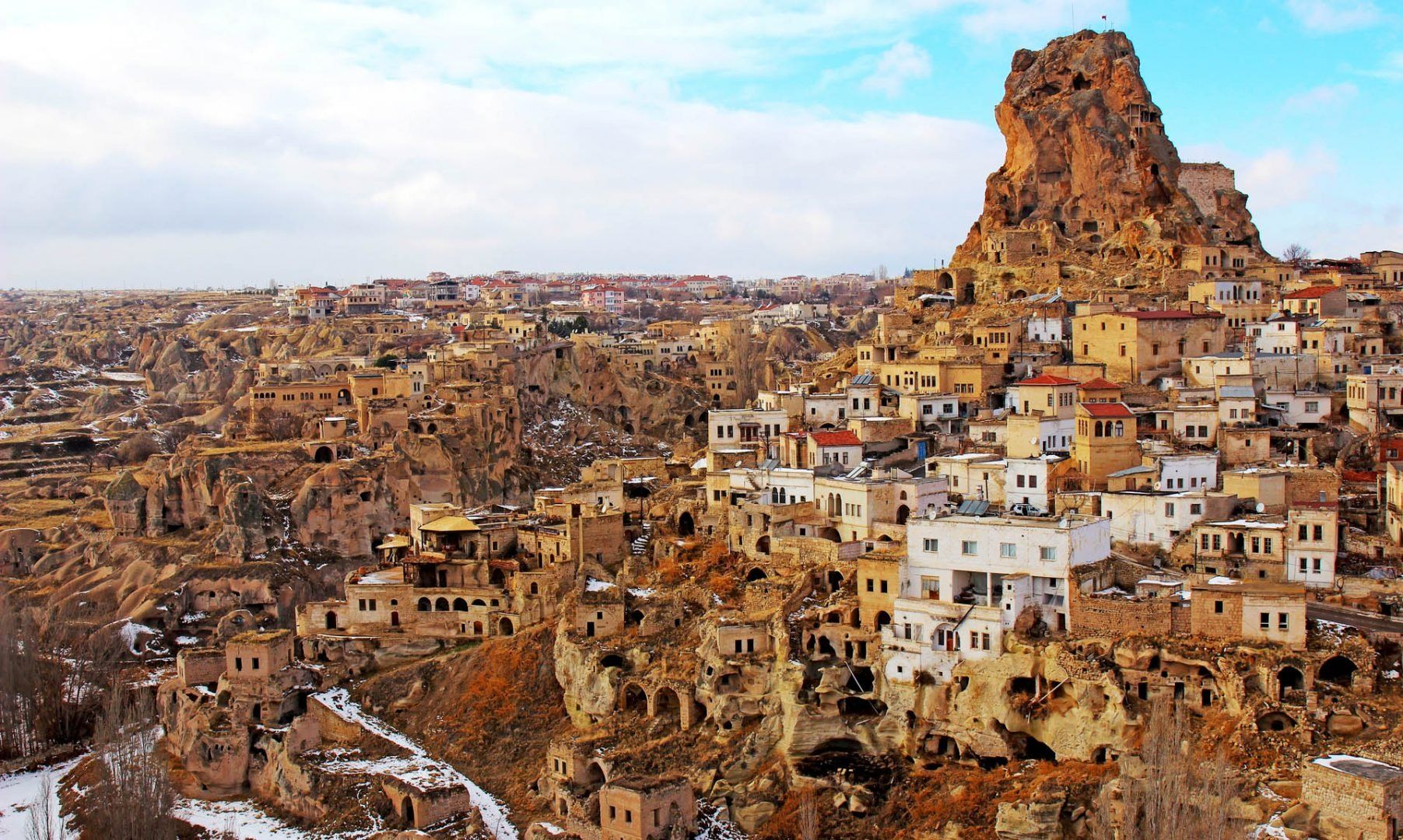
Cappadocia, Turkey © Shutterstock
On day 5 of this 7 day Turkey itinerary, head to Mustafapaşa village, formerly Sinasos. The streets show a mix of Ottoman and Greek architecture. From the village, hike about 2.2 miles (3.5 kilometers) through valleys where Byzantine monks carved churches into the rock.
Stop at Keslik Monastery to see how communities built self-sufficient settlements with wine production and defensive structures. In the afternoon, visit Sobessos, uncovered in 2002. Roman mosaics with geometric and mythological designs were preserved under volcanic ash for centuries and are now visible under farmland.
Insider's tip: The monastery’s refectory has carved stone tables where monks ate in silence.
Start near Ortahisar Castle and hike through Pancarlık and Üzengi valleys toward Ürgüp. The valleys grow Emir grapes, used for local white wines. Along the way, you’ll pass abandoned Greek mansions with carved stone facades still intact.
For lunch, stop at Ürgüp Kadın Kooperatifi, a women’s cooperative run by local residents. They prepare dishes like stuffed vine leaves and bulgur pilaf using traditional methods.
Insider's tip: Buy homemade preserves, especially rose petal jam. It supports the cooperative and is a great souvenir.

Goreme, Cappadocia, Turkey © Shutterstock
Spend the morning at a cave hamam in Göreme or Ürgüp. The traditional ritual includes steam, exfoliation with a kese mitt, and massage. Attendants guide you through the process from the heated marble areas to the exfoliation, leaving skin refreshed and soft.
For the farewell dinner, head to a pottery-themed kebab restaurant in Avanos. Meals are served in clay vessels similar to the ones you saw in the pottery workshops. Musicians often play traditional Turkish songs,
How would your perfect Turkey trip look? Our local experts make itineraries to match it.

Istanbul, Bosphorous Bridge, Turkey Goreme, Cappadocia, Turkey © Shutterstock
This 10-day Turkey itinerary covers the most visited parts of Turkey. You’ll spend a few days in Istanbul, see ancient sites around Ephesus, wander Pamukkale’s terraces, and move on to Cappadocia and the Mediterranean coast.It’s a lot to see, but it’s doable without rushing. More days could be added for a more relaxed pace.
When you land, make your way to Sultanahmet and settle in. In the evening, walk around the old city. The Blue Mosque and Hagia Sophia are lit up at night and give a sense of how layered the city is. Grab a meal nearby. Try kebabs or mezes and watch the city move around the monuments. It’s a good way to ease into Istanbul without feeling overwhelmed.
Insider's tip: Download the Istanbul Museum Pass app. It shows queue lengths and helps you plan what to see the next day.
Start with Hagia Sophia to see Byzantine mosaics and Ottoman calligraphy. From there, take a walk to the Blue Mosque to see the Iznik tiles and six minarets. The Hippodrome shows some of Constantinople’s old chariot-racing monuments, including the obelisks. You can step underground into the Basilica Cistern for cooler air and reflections in the water.
For the afternoon, make a visit to the Grand Bazaar, where thousands of shops sell carpets, spices, and other goods.
Insider's tip: Carry small Turkish lira bills. Vendors prefer cash, and having exact change helps when bargaining.
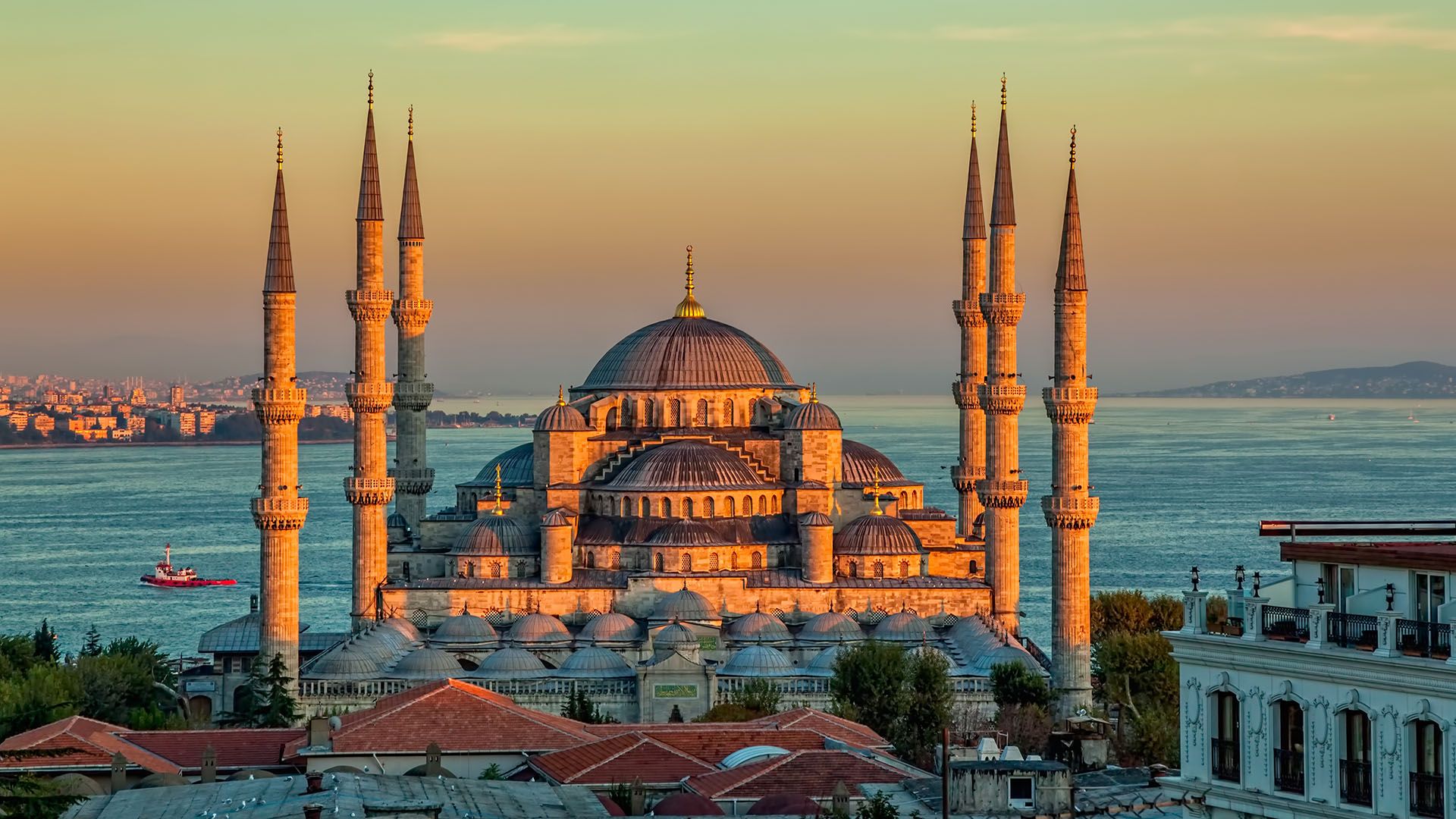
Blue mosque, Instanbul © OPIS Zagreb/Shutterstock
Travel time: About 3 hours including flight and transfers
Take a morning flight to Izmir. From the airport, it’s about 37 miles (60 km) to Selçuk. The road passes olive groves and vineyards that have been farmed since Roman times, around 2,000 years. Stop in Izmir if you want a quick snack—boyoz or gevrek are local pastries worth trying.
In Selçuk, the Ephesus Museum is a good introduction to the ruins. Then head into Ephesus itself. Walk the marble streets, see the Library of Celsus and the Grand Theatre. Pause and notice the steps people used two thousand years ago.
Insider's tip: Ask to see the Gladiator Room in the museum. It gives a glimpse of Roman entertainment culture that people often skip.
Travel time: 3 hours by road
On day 4 of this Turkey itinerary, the drive goes through the Menderes Valley and small villages. top in Nazilli or Sarayköy if you want to try gözleme, made fresh by women rolling it out by hand. As you approach Pamukkale, the white terraces stretch across the hillside. Above them, Hierapolis has a theatre, Roman baths, and a necropolis.
When you arrive, leave your shoes behind and step onto the terraces. The water is warm and mineral-rich, moving slowly across the calcium deposits. It feels different from anything else in Turkey, so pause, watch the water flow, and take it in slowly.
Insider's tip: Bring a waterproof phone case. The terraces are photogenic, but mineral water can damage devices.
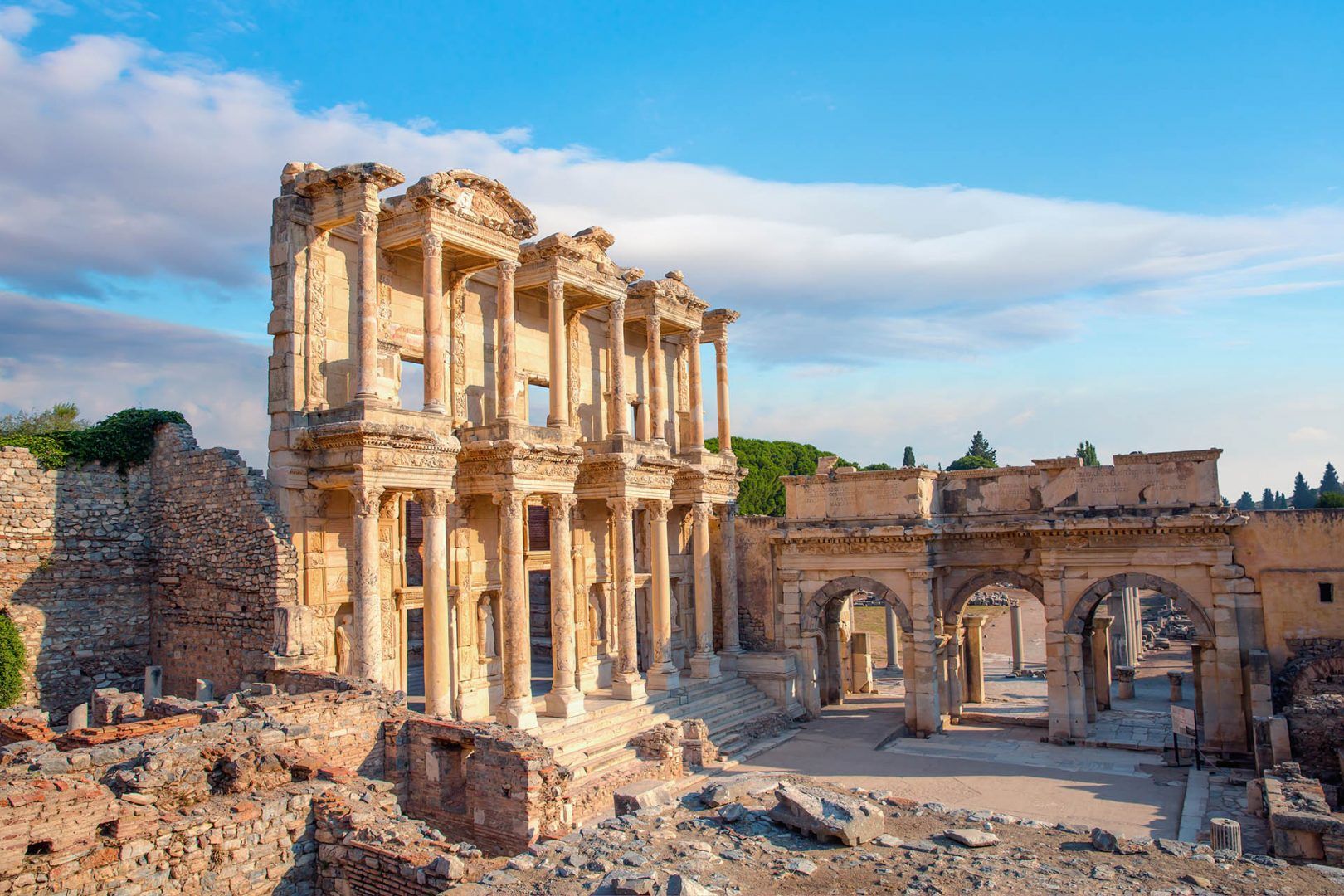
Ephesus, Turkey © OPIS Zagreb/Shutterstock
Travel time: 3.5 hours by road
You leave Pamukkale in the morning and follow the road across the Taurus Mountains. The landscape changes gradually as valleys open up into low hills. As you continue, you’ll start to see Mediterranean vegetation as you descend. About 30 miles (50 km) from the highway, Salda Lake is worth a short stop. The sand is bright white, the water clear, and it’s easy to stretch your legs here.
As you get closer to Antalya, Kaleiçi, the old city, comes into view. The streets are narrow and cobbled, lined with Ottoman houses inside the old Roman walls. Hadrian’s Gate is a clear marker, and the Yivli Minare Mosque stands out as you navigate the area. Walk around slowly and look at the restored buildings; many now house cafés or small hotels.
Insider's tip: Mermerli Beach has an entrance fee and clear water right in the old town, a good option for cooling off.
Walk into Perge and immediately notice the wide Roman street lined with crumbling columns. The theatre is huge. You can imagine thousands watching contests here. The stadium holds 12,000, and under the floor, the old heating system is still visible.
Take your time exploring. The stone can be slippery in the sun, so watch your footing. By afternoon, head down to Mermerli Beach. The water is clear and cool. The city walls behind you give the beach a quiet edge. Bring your phone in a waterproof case if you plan to swim.
Insider's tip: Go through the arches under the stadium. You can see where small shops once sold snacks to spectators.

Vibrant Pamukkale in Turkey © Suksamran1985/Shutterstock
Travel time: 6 hours total by road
You leave Antalya in the morning and drive north toward Aspendos. The Roman theatre is one of the best-preserved in Turkey. You can walk around the stage, look at the seating, and see how the structure is laid out. After exploring, you continue through Konya.
If time allows, stop for lunch and a quick visit to the Mevlana Museum to see the Whirling Dervishes. The road then crosses the Anatolian plateau, passing small villages and historic caravanserais. By evening, Cappadocia appears, with its distinctive fairy chimneys and cave churches. You check into a cave hotel with rooms carved into the rock.
Begin at Göreme Open Air Museum, moving through monasteries carved into fairy chimneys. The frescoes are worn but still show Byzantine scenes, and the narrow cave corridors give a sense of how monks lived. From there, head to Avanos for a pottery demonstration. The red clay has been shaped here for 4,000 years, and you can see techniques passed down through generations.
Next, explore Özkonak Underground City. The tunnels stretch across eight floors with ventilation shafts, chapels, and old wineries. Climb Uçhisar Castle after, and take in the wide views across valleys dotted with chimneys. End the day in Pigeon Valley, noticing cliffside dovecotes that once supplied fertilizer for vineyards.
Insider's tip: Check for the communication holes in Özkonak. Hot oil went through them to fend off invaders.

Cappadocia, Turkey © Pixabay
Start with a 2 mile (4 km) hike through Red Valley. The cliffs glow with a soft rose tint from iron oxide, and the trail winds past orchards, vineyards, and inhabited cave homes. Small chapels along the path still hold frescoes, though faded.
Stop for lunch at a local café like Seten in Göreme, where Central Anatolian dishes are served, and you can see how recipes have stayed consistent over time. In the afternoon, watch carpet-making and natural dyeing. Patterns carry meaning, often telling family or village histories.
Insider's tip: Ask your guide about the "wishing trees" along the trail. Locals tie fabric to them following an old tradition.
Travel time: 1.5 hours to airport
For your last day, ride to Kayseri or Nevşehir Airport passes villages and volcanic peaks. The route passes villages and volcanic peaks, giving one last chance for photos of fairy chimneys and valleys. Kayseri has more flight options, Nevşehir is closer.
Insider's tip: Kayseri Airport duty-free has a good range of Turkish delight and rose-flavored lokum. Buy it after security to avoid restrictions.
Ready to start planning? Local travel experts design itineraries tailored to you.

Vintage tram on the Taksim Istiklal street in Istanbul © Sotnikov Misha/Shutterstock
A two week itinerary in Turkey takes you from Istanbul’s old city to Cappadocia’s fairy chimneys and Mount Nemrut’s stone heads. The pace lets you explore ruins, landscapes, and towns without feeling rushed, while still seeing the highlights.
Start in Beyoğlu. The Galata Tower rises over narrow streets filled with galleries and vintage shops. From the top you can see the Golden Horn and the domes and minarets of Sultanahmet. Around the neighborhood, check out rooftop restaurants or small music venues. In the evening wander the alleys for meyhanes and sample meze plates while taking in the city rhythm.
Insider's tip: Get a Museum Pass Turkey before you arrive. It saves time at the main sites.
Travel time: 2.5 hours (flight)
Flights from Istanbul run frequently on Turkish Airlines and Pegasus. Take a morning flight to have the afternoon free. Shuttles connect the airport to the city in about 20 miles (35 km).
In the evening, attend a Sıra Gecesi. This is a traditional Turkish gathering, deeply rooted in Şanlıurfa's culture, where people come together to enjoy music, food, and conversation. Historically, these evenings were held among men and served as informal education in music, poetry, and social etiquette.. Today, many venues in Şanlıurfa host Sıra Gecesi events that are open to the public.
This traditional gathering is held in restored Ottoman mansions and features live Kurdish and Arabic music, folk dancing, and regional dishes like çiğ köfte and Urfa kebab.
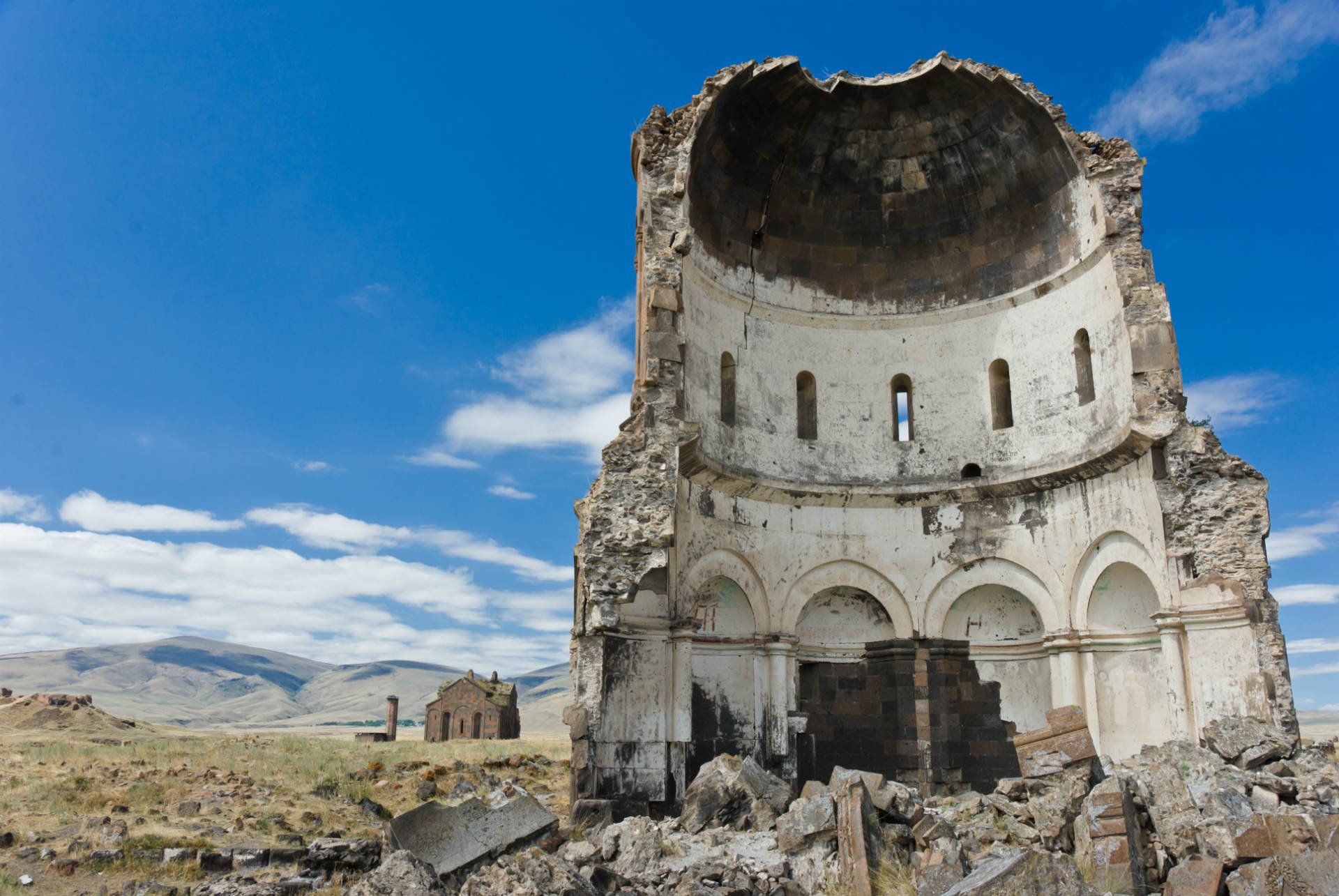
Church Redeemer Ani, Turkey © Shutterstock
Travel time: 2 hours (drive to Adiyaman)
Start the morning at Abraham’s Cave, considered the birthplace of the prophet. The cave is right next to the Holy Lake (Balıklıgöl), so you can walk from one to the other in just a few steps.
In the afternoon, drive out of Sanliurfa toward Harran, roughly 40–45 minutes away. The landscape opens into pistachio orchards and cotton fields. Stop to see the beehive houses, ancient cone-shaped dwellings still inhabited after 3,000 years.
Continue on to Göbekli Tepe, about 15–20 minutes from Harran. Walk among the massive stone pillars and carved reliefs, older than Stonehenge by 6,000 years. The paths are easy to follow and allow close-up views, giving a real sense of early human ingenuity.
Insider's tip: Bring snacks for Adiyaman. Restaurants close early but hotels serve food later.
Start the morning with a drive to Arsameia, the ancient Commagene city. Arsameia has rock reliefs and the longest Greek inscription in the world. The Roman Cendere Bridge still crosses the river with original columns.
In the afternoon, drive to Karakuş Tumulus, a burial mound for royal women. The eagle and lion statues at the top stand out against the sky, showing Persian and Greek influence.

Nemrut Dağı, Turkey © Shutterstock
Travel time: 7-8 hours (drive with stops)
You’ll need to wake up early to catch the sunrise on Mount Nemrut. The giant stone heads of gods are scattered across the summit, and the first light gives the place a quiet, unusual feel. King Antiochus I built his tomb-sanctuary here at 7,000 feet (2,134 meters), and though the statues have toppled over time, it’s easy to imagine the scale. The air is cold in the morning, so layer up.
The drive to Cappadocia goes across the Anatolian plateau and through Malatya, known for its apricots. That’s a common place to stop for lunch. Coaches are usually comfortable and the landscape keeps changing, from mountains to volcanic formations, until you hit Cappadocia. The D300 highway passes Kayseri before reaching the region.
Insider's tip: Grab some dried apricots in Malatya.
Northern Cappadocia is full of rock formations shaped over millions of years. Uchisar Castle is basically a massive rock you can climb into, and the views from the top cover the whole area. The Göreme Open-Air Museum has monasteries carved into cone-shaped rocks with Byzantine frescoes. Paşabağ has mushroom-shaped chimneys right by the path, and Devrent Valley has rocks shaped like animals that make wandering through it more interesting.
Insider's tip: Go to the Dark Church last. It’s dim inside, so your eyes adjust better after seeing other frescoes first.

Cappadocia, Turkey © Pixabay
South Cappadocia has valleys and underground cities. A morning walk through Red Valley passes rose-colored canyons and abandoned cave churches, and there are a few viewpoints along the way.
Çavuşin’s old Greek village is empty after rock falls but still has stone houses worth seeing. Love Valley has unusual rock formations along the trail. In the afternoon, Kaymaklı Underground City has eight levels with stables, wineries, and chapels. Early Christians built it so people could live hidden for months.
Insider's tip: Bring a small flashlight. Phone lights run out of battery fast in the lower levels.
Travel time: 8 hours (drive with stops)
You leave Cappadocia in the morning, following a route that roughly traces the old Silk Road. The first stop is Sultan Han Caravanserai, a large Seljuk-era inn with a wide courtyard and a carved portal that immediately shows the architectural style.
From here, the road stretches across Konya’s plains. If you pause in Konya, the Mevlana Museum is built around Rumi’s tomb. Manuscripts and musical instruments explain Sufism’s place in local culture. The drive continues into rolling hills and the mountains that lead into Pamukkale. Coaches often make short breaks along the way, giving time to stretch or take a photo.
Insider's tip: Pick up a bottle of rose water in Konya.

The Domitian Arch © Shutterstock
The terraces of Pamukkale are made of white calcium deposits, shaped by mineral-rich hot springs. Walk barefoot through the shallow pools; the water is warm and gentle on your feet. Above, Hierapolis ruins rise along the ridge. The theater and necropolis show how the city was once laid out. Cleopatra’s Pool sits below, Roman columns emerging from the water, making it feel both like a bath and a history lesson.
Insider's tip: Enter from the south near Karahayıt. There are fewer people here, and the light hits the terraces better for photos.
Travel time: 3 hours (drive)
The road goes down from Pamukkale through the Menderes Valley on the old Ephesus route. Highways make it straightforward. There are viewpoints over the Aegean coast. Some tours stop at leather outlets but there’s no need to go in unless you want.
Kusadasi’s harbor marks the start of the Aegean side of Turkey. Pigeon Island sits just offshore with a small Byzantine castle guarding the bay. Along the waterfront, seafood restaurants and bars line the promenade, and the old town has Ottoman fountains and traditional houses. It’s a good base for Ephesus, with beaches and nightlife that feel different from inland towns.
Insider's tip: Walk a little away from the cruise port. You’ll find more reasonable prices and local fish dishes like balık ekmek.

Galata Tower, Istanbul, Turkey © Shutterstock
Ephesus is easy to get lost in, and in a good way. Start at the Library of Celsus and take your time along the main street, letting the scale of the Grand Theater sink in. You can still hear your own voice clearly from the stage if you try. Walk through the terraced houses to see how mosaics and frescoes marked the homes of wealthy Romans. The Virgin Mary House is a short drive uphill and draws pilgrims, while St. John’s Basilica marks where the apostle was buried. One column of the Artemis Temple is all that remains, but it’s enough to get a sense of what it used to be.
Drive time to Izmir Airport is around an hour. Flights to Istanbul run throughout the evening on Turkish Airlines and Pegasus.
Insider's tip: The Ephesus Museum audio guide app is worth downloading before you go. WiFi on site doesn’t work well, and the app gives context you won’t get just walking around.
From Istanbul Airport, take a taxi, private transfer, or the Havaist airport bus into Sultanahmet. It’s about a 45-minute ride without traffic.
Topkapi Palace shows how Ottoman sultans lived. The treasures in the chambers include the Topkapi Dagger and relics tied to Prophet Muhammad. The harem is part of the tour, and wandering the gardens gives a bit of breathing space after all the history.
The Egyptian Spice Bazaar is a short tram ride from Topkapi Palace (take the T1 line to Eminönü). Move from stall to stall for an hour, taking in the smells, colors, and small crowds. A Bosphorus cruise departs from nearby docks and takes you past palaces, fortresses, and bridges linking Europe and Asia.

Istanbul skyline at dusk © Shutterstock
Start at Dolmabahce Palace, where European influence is obvious in the architecture. The chandelier alone catches your eye, and the reception halls are layered with gold leaf that makes you pause. Comparing this to older Ottoman buildings nearby shows how the empire’s style changed in its later years. From there, move toward Taksim Square and Istiklal Street. The streets feel lively and different, with historic trams rolling past shops and traditional meyhanes.
In the evening, visit a hamam for the full routine: steam, scrubs, and massage. This is more satisfying than just entering for a quick soak.
Begin at Chora Church, where quiet rooms let you focus on mosaics and frescoes detailing biblical stories. From there, explore Fener and Balat. The streets are lined with colorful houses, churches, and synagogues. Antique shops and cafés give the neighborhoods life without feeling staged for tourists. Finish the day with dinner and folk dancing from different region.
Insider's tip: Hire a local guide for Fener-Balat. Residents tell stories about Greek, Jewish, and Armenian heritage that aren’t in guidebooks.

Beach as known Gizli Liman or Ugurlu in Turkish at Gokceada, Turkey © Shutterstock
Rough Guides’ local Turkey travel experts can help you plan an itinerary that matches your interests and travel style. If you enjoy Byzantine architecture, want to explore Turkey’s food scene, or plan to spend time in national parks, they can shape your route around what matters to you.
They handle the practical details, from booking cave hotels in Cappadocia to arranging private guides at Ephesus, reserving tables at Istanbul lokantalar, and setting up cooking classes with local families. You’ll also have support throughout your trip, 24/7, in case plans need shifting in the moment. If you want a Turkey itinerary designed just for you, request a free trip plan from us.

Harem in Topkapi Palace, Istanbul, Turkey © AdobeStock
Turkey is big, so it helps to pick a focus. Some travelers stick to the Aegean and Mediterranean coast for beaches and seaside towns, while others head inland for Cappadocia’s valleys and fairy chimneys, or explore Istanbul and the country’s historic sites. Here are some other Turkey itineraries to consider.
In this 7 day Turkey itinerary, you’ll get a mix of history and everyday city life. Hagia Sophia and the Blue Mosque are must-sees, the Bosphorus gives a different perspective, neighborhoods like Fener and Balat show how people live, and the Princes Islands are a quieter change from the city.

Hiking on Lycian way trail © art of line/Shutterstock
This itinerary keeps travel manageable for families while covering Turkey’s main highlights. You’ll start in Istanbul, then fly to Cappadocia to explore the landscape, and finish in Pamukkale with its terraces and ancient ruins. Flights between destinations save time.

Ancient amphitheater Aspendos in Antalya, Turkey © Ryzhkov Oleksandr/Shutterstock
If you want to thoroughly see Turkey, this three-week route takes you through the range of Turkey’s landscapes and culture. You’ll move from Istanbul to ancient ruins, the Mediterranean coast, Cappadocia’s unusual terrain, and traditional Anatolian towns. The pace lets you experience the country fully without feeling rushed.

Butterfly Valley ( Kelebekler Vadisi ) view in Fethiye Town of Turkey © Najdet Duzen/Shutterstock

Dervishes in Turkey © art of line/Shutterstock
These FAQs cover practical details to help plan your Turkey itinerary efficiently and avoid common travel hassles.
A meaningful trip usually runs 10-14 days. That gives you 3-4 days in Istanbul, 2-3 days in Cappadocia, and time to reach either the Mediterranean coast or historical sites like Ephesus.
A week is enough for Istanbul and one other region but feels rushed. Three weeks allows a more complete circuit including eastern regions. Istanbul alone needs 4 days to cover both continents, main monuments, and neighborhoods. Domestic flights save time but add cost.
April and May or September and October usually is the best time to visit Turkey. These months have comfortable temperatures between 15-25°C, fewer crowds, and lower accommodation prices. Spring brings wildflowers and good hiking conditions. Autumn still allows swimming in the sea and coincides with harvest season.
July and August are hot and busy, especially at archaeological sites, though the coast stays appealing. Winter works for city breaks in Istanbul and snowy Cappadocia landscapes, but many coastal hotels close and travel in eastern regions becomes harder.
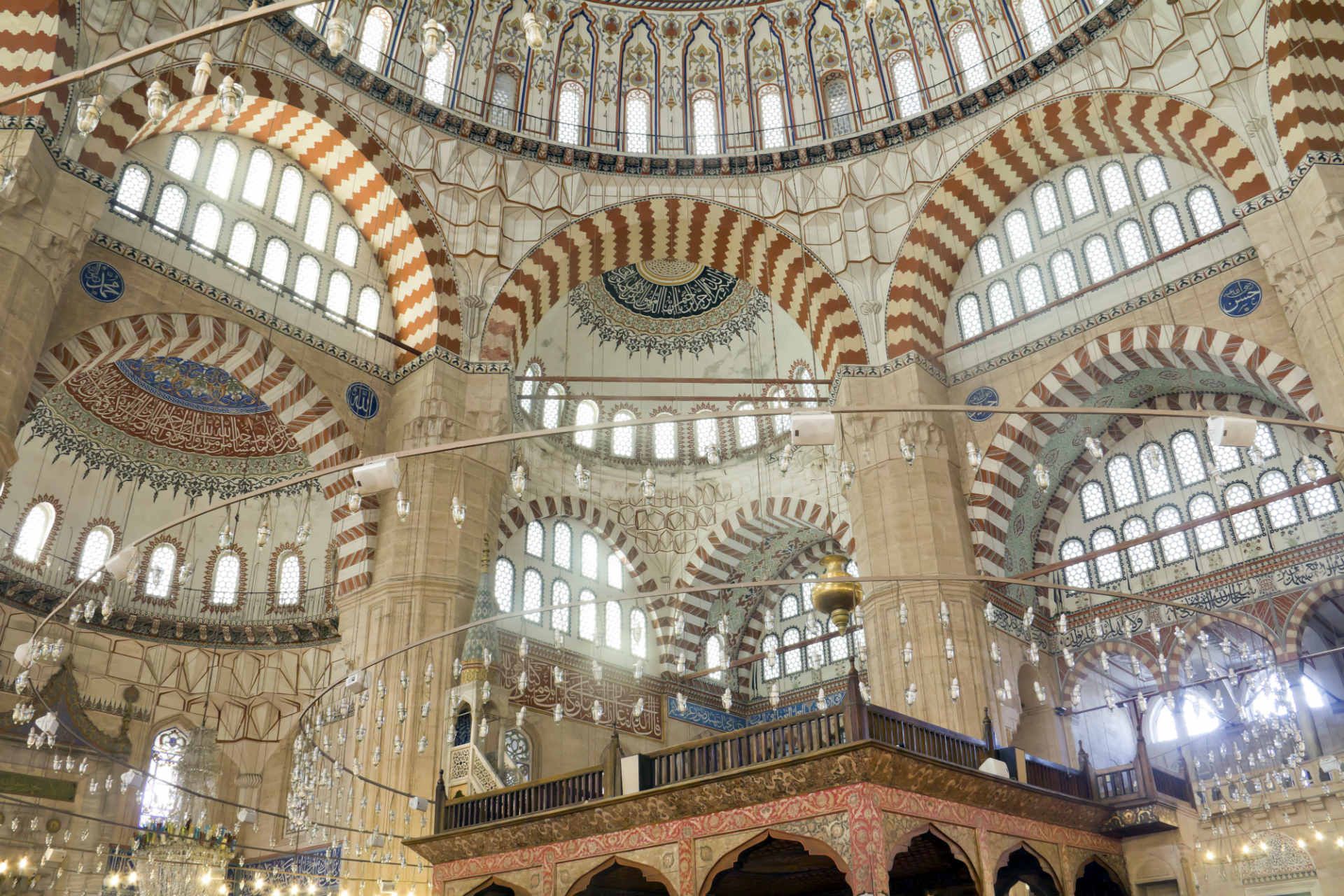
Selimiye Mosque Butterfly Valley ( Kelebekler Vadisi ) view in Fethiye Town of Turkey © Shutterstock
Buses connect towns and cities reliably. Metro Turizm and Kamil Koç run comfortable coaches with WiFi and drinks. Domestic flights with Turkish Airlines or Pegasus shorten long trips, for example Istanbul to Cappadocia takes 1.5 hours by plane instead of 10 by road.
Rental cars work well for coastal drives or remote sites but can be stressful in big cities. Trains are limited, though the Istanbul to Ankara high-speed line is convenient.
Yes. Istanbul’s public transport covers most areas. Istanbulkart works on metro, tram, ferry, bus, and funicular lines. Ferries across the Bosphorus are scenic and practical. M1 metro connects to the airport. Trams reach Sultanahmet’s key sites. Walking neighborhoods like Galata and Karaköy is enjoyable. Driving is difficult because of traffic and limited parking. Taxis are useful for late nights or to reach hillside viewpoints. BiTaksi app helps find taxis with upfront pricing.

Bosphorus Bridge Istanbul © Shutterstock
Daily budgets range from $100 for backpackers to $250+ for travelers seeking comfort. Meals run $5-15 at local eateries and $20-40 at higher-end restaurants. Entry fees for main attractions are $10-20. Museum Pass Istanbul costs $48 for 5 days and can save money if you visit multiple sites. Domestic flights cost $30-100, buses $15-40. Cappadocia balloon rides are the largest expense at $150-250. Street food and markets keep food costs low. Tourist-heavy areas charge more. Add some budget for hammams, guided tours, and shopping at the Grand Bazaar.
Istanbul needs 3-4 full days to see main sights, neighborhoods, and markets. Beyond that, it depends on your interests. History enthusiasts may spend 2 days in Ephesus and surrounding areas. Beachgoers may want 3-4 days on the Turquoise Coast. Cappadocia requires 2-3 days for valleys and underground cities.
A two-week itinerary could be 4 days Istanbul, 3 days Cappadocia, 2 days Ephesus area, 3 days Mediterranean coast, with travel days in between. Turkey spans 1,600 kilometers east to west. First-time visitors often do best with Istanbul, Cappadocia, and Ephesus instead of trying to cover everything.

Istanbul, Turkey © Seqoya/Shutterstock
Yes. Crossing continents gives a fuller view of Istanbul beyond the European side. Sultanahmet and Galata have major monuments. The Asian side has neighborhoods, markets, and restaurants locals use. Kadıköy has great markets and dining. Üsküdar has mosques without crowds and sunset views across the water. You’ll want to allocate a full day for Kadıköy and Moda, ending with sunset at Çamlıca Hill. Prices for food are often lower and it shows a side of Istanbul less dominated by tourists.
The eastern part of the map of Turkey is rewarding to visit but takes time and planning. Travel is slower and services are more limited. Expect 7-10 days minimum, with flights usually via Ankara or Istanbul. Highlights include Ani’s ruins near the Armenian border, Lake Van and Akdamar Island, and Mount Nemrut’s statues.
Mount Ararat requires climbing permits and experience. Some border areas may face occasional security concerns. For trips under three weeks, most first-time visitors get more from western Turkey where sites, transport, and services are easier to access.

Mount Ararat © Shutterstock
You’ll want to dress modestly at mosques. Women should cover their head, and both genders should cover shoulders and knees. Remove shoes in mosques and homes.
Public displays of affection are rare, espescially outside tourist areas. Learning “Merhaba” (hello) and “Teşekkürler” (thanks) goes far. If your visiting during Ramadan, try to eat discreetly in order to not be rude. Tipping is appreciated but not obligatory. A tip of 10% is considered appropriate at most places.
Want your trip to run smoothly from start to finish? Rough Guides’ local travel experts know the area well and will take care of everything: planning, booking, and round-the-clock support, so you don’t have to. Learn more about our tailor made trips.
From travel safety to visa requirements, discover the best tips for visiting Turkey
Discover Turkey's most captivating stories
written by
Dre Roelandt
updated 24.09.2025
Dre Roelandt is originally from the United States but lives and works in Berlin, Germany. Dre is a freelance writer and artist with a passion for travelling. They are an in-house Senior Content Editor at Rough Guides.
Arrange your trip, hassle-free, with local travel experts
Arrange your trip with local travel experts